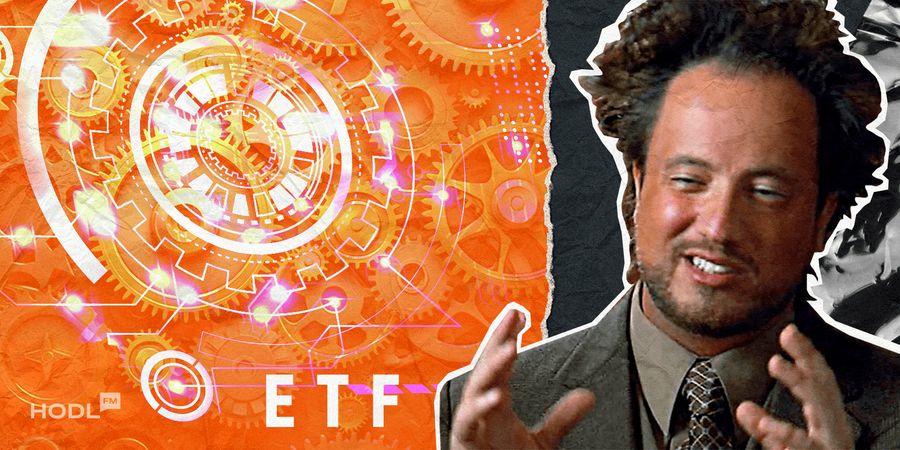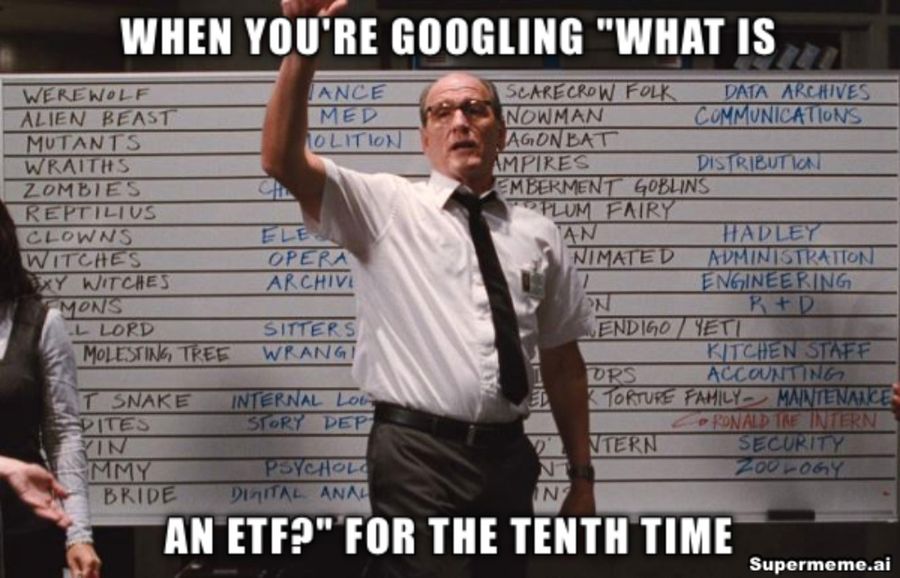It’s the smart investor who has learned from experience the secret of successful investment trading: buy from pessimists and sell to optimists. But for the rest who haven’t learned this secret of transferring money from the impatient to the patient, the stock market is both attractive and intimidating.
While the markets remain highly unpredictable, and there’s always a degree of risk, good investment choices and strategies can offer a way to minimize risk and make significant returns. Investing in an exchange-traded fund is one such strategy, and our guide explains the basics of ETFs to enable you to get grips with it.
Read more: Betting on Bitcoin: Bloomberg Analysts Raise the Stakes on ETF Approval
What does “ETF” mean?
Invented in the early 1990s, ETF, or Exchange-Traded Funds, is a type of investment fund that is traded on the stock exchange just like equities. The genesis of ETFs was the search for a way of tracking stocks using indices like FTSE 100, Dow Jones Industrial Average and S&P 500, among others.
While investors traditionally used ETFs to track indices mainly, ETFs are becoming more sophisticated. Today, there’s so much diversification they are used to track other assets, including bonds, real estate, cryptocurrencies and commodities like gold and oil. The unique thing about these diverse ETFs is their ability to mimic the stocks they’re traded easily.
Types of ETFs
While they are traded like stocks, the ETF market is as diverse as they come, with some types being traded like index funds and others like mutual funds. As they try to capture a wide array of public equities, this makes them vary greatly regarding investment goals and their underlying assets.
Beginning with the pioneer ETF, Standard & Poor’s Depository Receipt (SPDR), launched in 1993 on the American Stock Exchange, ETFs are now among the largest sectors of the financial industry. Among the most common types of ETF include the following:
- Market ETFs: Market ETFs expose users to representative samples of stock markets as they track significant indices. An index like the S&P 500 becomes a measure of the type of market the ETF will be trying to track.
- Stock ETFs: These are stocks designed for long-term growth. They may not be as risky as individual stocks, but they still carry more risk than others, like bond ETFs listed here, to name a few.
- Sector ETFs: These are exchange-traded funds designed to track specific sectors or industries in the stock market. Some examples are energy stocks or healthcare stocks.
- Style ETFs: Style ETFs will track selected investment styles in the stock markets like a company’s market capitalization: the commodity’s small cap, large cap, etc. and whether it’s a value of growth stock.
- Foreign Market ETFs: These are designed to expose users to international stock markets. These could be individual, country or regional stock markets.
- Bond ETFs: With Bond ETFs, you get exposed to bonds like municipal, corporate, treasury, international and high-yield stocks.
- Commodity ETFs: A Commodity ETF is designed to track the price of different essential commodities, including oil, precious metals like gold or any other commodity.
- Real Estate ETFs: With this type of ETF, you get exposed to real estate markets mainly through Real Estate Investment Trusts (REITS).
- Crypto ETFs: Ether and Bitcoin ETFs expose investors wishing to expand their portfolio to cryptocurrency trade without holding actual crypto assets. Such ETFs provide shares in baskets of Ether of Bitcoin futures contracts.
Furthermore, many other ETFs exist, including actively-managed ETFs or those offering alternative investments. While ETFs are primarily passive and track indices, a growing number of managed ETFs exist.
How do ETFs work?
ETF providers combine assets like commodities, bonds, stocks, etc., into baskets before linking them using unique market tickers. This may include commodities like gold or indexes like the Bloomberg Barclays US Aggregate Index, S&P 500, etc. The basket of securities offers an intraday trading price and is put up on sale like a company’s stock.
Unlike mutual funds, where traders are allowed to buy or sell only once during the day, investors are then allowed to buy or sell a share of the ETF at any time during the trading day. Nonetheless, the trader doesn’t own the ETF’s underlying asset.
While UTF trading mimics the stock market, the outstanding number of ETF sharers could vary daily. That’s because new shares can be added at will, and redemption occurs daily. It’s the process of making a creation and redemption that enables ETFs to match the price of their underlying security.

ETF Advantages and Disadvantages
Advantages
Ease of Trading
Since ETFs are traded in the stock market, buying and selling throughout the day is easy because prices are updated in real-time. ETF investors can accomplish trades through the same brokers as stock traders and place special orders like limit orders, just like with stocks.
Fees
Comparing ETFs vs. mutual funds, ETFs have lower expense ratios (annual fees) than mutual funds. However, note that brokerage commissions, which involve the cost of trading securities in brokerage accounts, could apply.
Diversification
ETF investment is a cheap and easy way of achieving investment strategy diversification. You can own hundreds of investments within your portfolio with the click of a button since there are different types of ETFs.
Liquidity
ETF shares offer more liquidity than mutual fund shares because of the way they’re designed.
Disadvantages of ETFs
Complicated Trading Process
Since ETF prices are updated in real-time, the ease of trading could tempt some investors to retrieve some investment holdings they had earmarked for the long term.
Extra Fees
While ETF fees are relatively lower than traditional mutual funds, some brokerages charge on trades, meaning applicable commissions and fund management fees could make them more expensive than regular stocks.
Lower Yield
ETFs are a great investment vehicle for anyone interested in getting exposure to broad financial markets. However, the dividends you accrue from this asset class can be a little lower than expected, mainly because indirect exposure to some assets dilutes your gains when the asset price shoots up compared to the entire market.

How much do ETFs cost?
The costs associated with exchange-traded funds may vary significantly, but on average, they range from about $59.42 by trade volume. The lowest recorded price of an EFT is $3.43, while on top of the list is $473.56. ETFs may be similar to mutual funds, but they trade intraday, and while they’re affordable, you can expect specific fees here and there.
There are expenses associated with different funds’ expense rations or chargeable fees for managing and maintaining an ETF that you must consider when researching. Nonetheless, ETF expense ratios could be slightly lower than other funds since most are passively managed.
The most common fee is the operating expense ratio (OER), which results from owning the ETF. Other trading costs include bid/ask spreads and commissions where applicable. There may also be changes in premiums and discounts to your ETF’s NAV (net asset value) that could significantly impact the total ownership costs you will incur.
If you choose between several ETFs tracking the same market index, doing a little homework will pay off since you must compare their expense ratios to ensure you select one with the most affordable OER versions.
The current influence of ETF on Bitcoin
There’s much excitement following news that a spot market Bitcoin ETF could be listed on the market by the end of 2023. This is after the US Securities and Exchange Commission (SEC) ran out the clock on applying to the US Court of Appeals after the court condemned the securities regulator for seemingly being biased by approving futures-based ETFs while denying similar spot market-based products.
For example, the price of Bitcoin surged 5% and hit $30,000 on Monday, October 16, 2023, following an erroneous report that the SEC had approved BlackRock’s Bitcoin spot ETF. The now-retracted story on Twitter, which BlackRock denied, was enough to catapult the price of Bitcoin from around $27,750 to over $30,000 before settling back to just above $28,000.
The possibility of approving a spot Bitcoin ETF has been a holy grail within the crypto community for years, as most people see it as a significant launching pad for the mainstream adoption of cryptocurrencies and their acceptance by mainstream financial institutions.
Such a decision would make institutional investors shareholders in some existing futures-based bitcoin ETFs in the U.S. and beyond. Bloomberg analyst James Sefffart believes there’s a 90% chance that SEC could approve a Bitcoin spot ETF by January 2024.
Conclusion
ETFs place different investment products into baskets, exposing investors to varied underlying securities in a singular package. As a result, there’s every chance you could get an ETF tailored to your individual needs, no matter what theme or market you’re looking into.
Read More Info:
- Decoding the Delay: SEC Extends Bitcoin ETF Approval Timeline to 2024
- Exploring Leveraged Bitcoin ETFs
Considering that ETFs combine the bundling of mutual funds with ease of trading in the stock market, some people will prefer taking the DIY approach in investing in ETFs. While that’s doable, most expert investors would instead take the professional portfolio management route to benefit from expert tips throughout their investment journey.
The ETF marketplace has experienced tremendous changes throughout its existence in the past close to 27 years, and more ETFs have meant bringing additional traders on board. Like with all financial products, it’s your responsibility to carefully study and understand ETFs to make the right investment decisions to match your needs. Don’t hesitate to seek professional financial advice to get the proper support.







